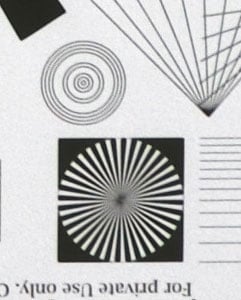Nikon Micro 105mm f2.8G VR review
-
-
Written by Thomas
Quality
Testing: Longitudinal Chromatic Aberration
Axial color (longitudinal CA, loCA) is a very common problem with large aperture primes and is not as easy to correct in post processing (or in-camera) as lateral CAs. Longitudinal CAs create some greenish tint with background subjects and a magenta tint on foreground subjects.
Below left is the result for the 105/2.8G showing a 100% crop at f2.8. The loCA effect is relatively mild and almost completely gone by stopping down to f5.6. Processing was done in Capture NX 2 with standard settings meaning lateral CA removal was ON, loCA removal = OFF. Below right you see the results from setting loCA removal to 50% in Capture NX.
Nikon AF-S VR Micro-Nikkor 105mm f/2.8G IF-ED Longitudinal Chromatic Aberration (loCA) | ||
 |  | |
| 100% crop, f2.8, loCA removal OFF in Capture NX2 | 100% crop, f2.8, loCA removal 50% in Capture NX2 | |
Sharpness and contrast
Let’s have a look at the theoretical performance (MTF-charts) of the new lens before analyzing the results from the test-shots:
| Nikon Micro-Nikkor MTF | ||||
 |  |  | ||
DX Micro-Nikkor 40mm f/2.8G | DX Micro-Nikkor 85mm f/3.5G VR | VR Micro-Nikkor 105mm f/2.8G | ||
These charts show the lens-performance at the largest aperture. To read these charts you only have to understand that higher values are better and that the closer the dotted and the continuous lines are together the less astigmatism (= resolution depends on the orientation of the test-pattern) the lens displays. The DX-corners where I measure with the D300 are approximately at 12mm on the X-axis.
From the charts the 105/2.8 should perform very well with very high contrast over the complete image-field and good sharpness that deteriorates only outside the DX image-circle towards the corners of an FX-sensor. But to really understand what this lens can produce we need to look at real test-shots with a challenging target, the Siemens-stars, with different apertures and different shooting distances. Because performing well at larger magnifications is no easy feat – otherwise people would be only buying extension tubes.
This comparison comes in two parts: center and corner performance at normal distances (around 3m, 1:35 magnification), followed by center and corner performance at macro distances (around 40cm, 1:2.6 magnification). For comparative purposes with my DX 40mm and DX 85mm Micro Nikkor reviews, I tested the 105mm with a DX-format body only. But I’ll supplement this review with FX results the next time I get my hands on a suitable body.
Processing was done in CaptureNX2 at standard settings, with white-balance adjusted to a neutral white and some exposure compensation to make the brightness match. CA-removal is ON. Focus was achieved as usual in live-view with a little optimization by hand and was performaned separately for the center and the corners to avoid any effect from field curvature.
These are all 100% crops!
| Part 1: Center- and corner-performance at standard (1:35) magnification (around 3m) Shot from a printed test-target
Part 2: Center- and corner-performance at around 1:2.6 magnification (around 40cm)
|
At larger magnifications the center of this lens is pretty good straight from the largest aperture, which is f3.3 at a magnification of 1:2.6. The corner is clearly weaker and shows some pronounced astigmatism. For best close-up results I’d suggest stopping down to f8. Overall the performance for shooting close-up is pretty good considering that you normally have to close the aperture a bit to get a sufficiently large depth-of-field at magnifications larger than 1:3. Again if you’d like to compare the quality of this lens to the Nikon AF-S DX Micro-Nikkor 40mm f/2.8G and the Nikon AF-S DX Micro-Nikkor 85mm f/3.5 VR see my Nikon Micro-Nikkor lens comparison.






















